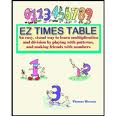I happened to come across an interesting article on www.Timesonline.com, the London Times’ website. What caught my attention was the title: “Who’s Afraid of the Seven Times Table?” by Dr. Ian Stewart, Emeritus Professor of Mathematics at the University of Warwick
When I developed my method for my son, we found table 7 the most difficult. Why? First of all, 7 in an odd number. Even numbers are easy. Table 10 has a super easy pattern and then tables 2, 4, 6 and 8 all end in some combination of 2-4-6-8-0! How easy is that? Now for the tables for odd numbers 1, 3, 5, 7 and 9. Table 1 is a cinch, as is table 5 with its super easy pattern (don’t you love the rhyme?) and how about the pattern for 9? Could any table be more fun? Number 0-9 in the left column and 9 to 0 on the right. See, you just completed table 9! All multiples of 9 add up to 9. Go ahead and try it: 18 (1 +9), 27 (2 + 9) and so on!
I knew if the 9’s had a fun pattern, so would the 3’s because 9 is a multiple of 3 and math is always logical. So my son and I sat down and guess what? When you add up the multiples of 3, you get a 3-6-9 pattern. Go ahead and try it: 12 (1+2), 15 (1+5), 18 (1+8). So now only table 7 was left for us to ponder. What I discovered is the last number decreases by 3. So its pattern is the opposite of table 3 which increases by 3.
In Teach Your Child the Multiplication Tables, I present the tables in order of difficulty. First, come tables 1 & 10, then tables 2 and 8 because of their similar patterns and then tables 4 and 6. Now come odd numbers in this order: 5, 9, 3 and 7. After publishing my book, it was gratifying to discover that mathematicians opined that table 7 was indeed the hardest to master.
In his article, Dr. Stewart states there are better ways of teaching the times tables than rote memorization. That, in fact, “times tables need not be boring at all.” He goes on to say, “There are lots of hidden patterns in the numbers, lots of easy short cuts, lots of interesting fact with which to have fun.” That’s what I found too.
Dr. Stewart describes the pattern for tables 10, 5, 9 and 7. The last number of the 7’s, he explains, decreases by 3 . He explains how you can figure out the 7’x on your mobile phone keypad. You can do this because of how the numbers are configured on the keypad. The column on the left is : 1, 4 and 7. Start with the 7 in the bottom row and work upward. 7 x 1 = 7. Move up the keypad to 4 and 7 x 2 =14. Move up to 1 for the third operation and 7 x 3= 21. Patterns are fun!
Our mind is designed to search for patterns. Patterns please us. Babies react more favorable to symmetical faces. Symmetry is a pleasing pattern.
Patterns are easy to remember because we learn one rule and apply it to the whole. If I told you my phone number was (214) 314-4114, you instantly would recognize a pattern and might not need to write the number down. So why not learn easy patterns for each of the tables?
My son loved disvereing patterns. There’s excitement in discovery. I published Teach Your Child the Multiplication Tables to help other families. If all third graders thought “math is cool,” we’d have fewer school dropouts. I won’t begin to ennumerate here the social consequences of children in the U.S. and elsewhere not knowing their times tables. What I will do is urge parents to teach their children their times tables. This skill is too important to be left to schools alone. You can do it. Better yet, you must do it.

